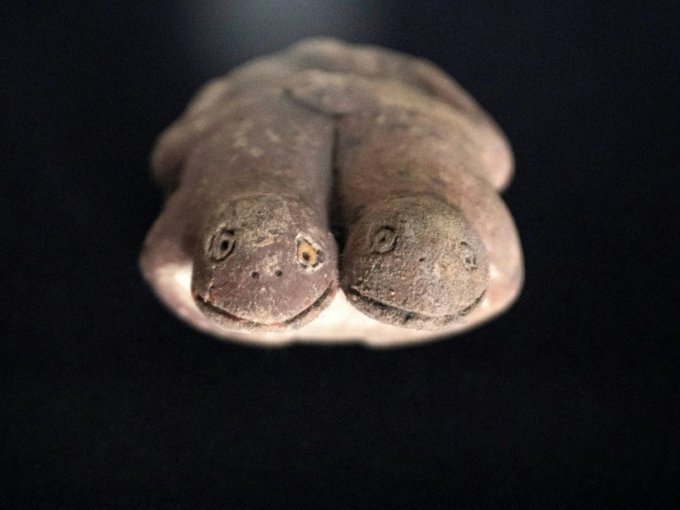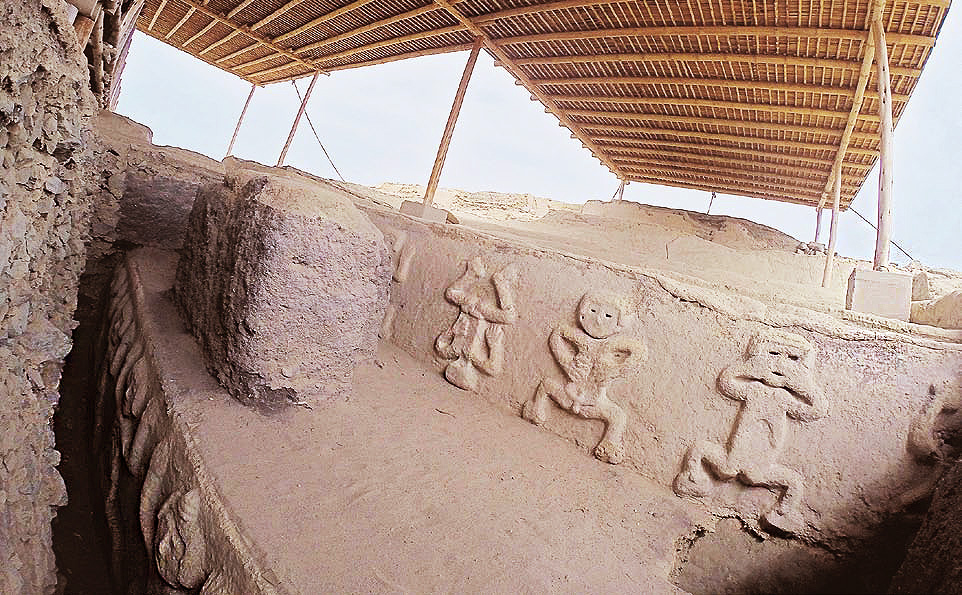Latin America
Related: About this forumArchaeologists Discover Rare 3,800-Year-Old Clay Figurine of Frogs at Peru's Vichama Site

Archaeologists in Peru have announced a remarkable discovery: a 3,800-year-old Clay figurine depicting two frogs, unearthed at the Vichama archaeological site, part of the broader cultural sphere of the Caral civilization—the oldest known civilization in the Americas.
The finding was revealed by Peru’s Ministry of Culture and has drawn attention from researchers worldwide for its symbolic meaning and historical importance. Measuring about 12 centimeters in length, the clay figure represents two small frogs joined at their hind legs. According to experts, this is the first time a clay sculpture of this type has been discovered in Caral-related sites.
Symbolism of Frogs in Andean Culture
Tatiana Abad, lead archaeologist and director of excavations at Vichama, explained that frogs played a significant symbolic role in the Andean worldview.
“In the Andean cosmos, frogs are associated with water and rainfall, essential elements for agricultural cycles and survival in ancient societies,” she said during a press conference in Lima.
The sculpture’s imagery fits with other reliefs and carvings found at Vichama, which portray scenes of scarcity, fertility, and renewal. These artistic representations are believed to reflect the community’s response to environmental crises and climate change that the Caral civilization faced thousands of years ago.
More:
https://arkeonews.net/archaeologists-discover-rare-3800-year-old-clay-figurine-of-frogs-at-perus-vichama-site/





Vichama Archaeological Center
Sorry, Spanish language documentary, interesting images, however.
Judi Lynn
(163,994 posts)Updated 21 August, 2019 - 01:55 Alicia McDermott

The newly uncovered wall carvings found in Vichama, Peru.
3,800 years ago, the people living in what is now called Vichama, Peru carved snakes and human heads into their walls alongside depictions of emaciated people. They were starving and dying and hoped a water deity would finally be lenient and send them some rain to let their friends, family, and neighbors survive.
According to archaeologist Ruth Shady, who leads excavations at the site, their pleas were answered. Experts arrived at this conclusion when they recently unearthed a carving of a human-like toad inside a ceremonial complex. In traditional Andean belief, a depiction of a toad can be used as a symbol for rain.
The toad figure is shown wrapping its hands around a human face below, which suggests that the people of Vichama were waiting for, or receiving, the rainfall that was so badly needed. Archaeologist Tatiana Abad states the mural appears to represent the “announcement of the arrival of water.”

The wall carvings found in Vichama, Peru, in 2018. (Zona Arqueológica Caral / Andina)
Other Carvings Discovered Nearby
Last year, wall carvings were located inside of the same structure where the rain representation was found. These stretch across a one meter (3.2 feet) high and 2.8 meters (9.2 feet) long adobe wall at the entry point of a ceremonial hall. That wall relief depicts four human heads with their eyes-closed and two snakes passing between and around them. These two snakes have their heads pointing at the image of what DW describes as “a humanoid seed symbol that is digging into the soil.”

The humanoid seed. (Ministerio de Cultura)
More:
https://www.ancient-origins.net/news-history-archaeology/wall-carvings-0010573
Haggard Celine
(17,589 posts)Looks like a Keith Haring creation.
Judi Lynn
(163,994 posts)I hate to admit it, I don't know anything at all about current artists, and these images were all new to me. I found one quickly with clear similarity to some Vichama art! OMG!

From an exhibition in Paris. Wow!
Thanks for introducing the name to someone who has been unaware of newer artists altogether! Very glad to find out, for sure. ![]()
Haggard Celine
(17,589 posts)I love Haring's work. It's uncanny how he tapped into something primal in his art. It's almost cartoonish, but it looks like art from ancient history in some respects. Glad you like it. ![]()
Judi Lynn
(163,994 posts)The 3,800-year-old statuette dates back to the oldest known civilization in the Americas.
Andrew Paul
Published Sep 2, 2025 11:44 AM EDT

The Caral people viewed frogs as symbols of water and rainfall. Credit: Peru Ministry of Culture
The Americas’ oldest known civilization had a thing for frogs. At an archaeological site about 68 miles north of Lima, Peru, investigators recently discovered a first-of-its-kind statue attesting to the Caral people’s affinity for amphibians. The tiny, symbolic artwork and other discoveries presented at a recent Ministry of Culture press conference highlight 18 years’ worth of excavation, conservation, and research at Vichama, a site inside the Caral Archaeological Zone (ZAC) in Peru’s Huaura Valley.
The Caral civilization
Also known as Norte Chico, the Caral civilization existed almost 5,000 years ago, placing the Andean culture alongside the rise of ancient Egypt. The Caral people represent the earliest known example of a complex society in the Americas, with experts often comparing their advancements to those in the Indus Valley and Mesopotamia.
At its height, the Caral civilization included an estimated 30 urban centers linked by trade, agriculture, fishing, and religious beliefs across present-day Peru’s north-central coast. The Caral managed these expansions without ceramics or widespread warfare. Despite this, the Caral’s influence reverberated into the Chavín and Moche peoples, as well as the later Inca Empire.
Stories of ‘shortages and hope.’ And frogs.
Archaeologists have spent nearly two decades combing through the Vichama site, which served as an urban agricultural and fishing hub around 1,800 BCE. Vichama featured at least 28 major structures including public buildings, homes, and ceremonial plazas within an area of only about a tenth of a mile.
Experts highlighted a pair of unfired clay models of buildings that emphasize the Caral culture’s understanding of urban planning and symbolic value. But the team placed particular importance on a remarkably well-preserved, 4.72 inch long sculpture of two frogs joined at the hind legs. The discovery is the first artwork of its type found at a Caral site, and speaks to the amphibians’ cultural significance.
“In the Andean cosmos, frogs are associated with water and rainfall, essential elements for agricultural cycles and survival in ancient societies,” lead archaeologist Tatiana Abad said during the press conference.
More:
https://www.popsci.com/science/ancient-frog-statue-caral-peru/